For a while now, I have been talking about the automobile and engines that are of great interest to me. The truth is, I don’t think I can ever get tired of those awesome gifts of technology.
Why not let’s do a little revision. The automobile (and other similar machines) is powered by the internal combustion engine (engine that runs as a result of a fuel burnt inside it). The energy expended by burning the fuel is converted to mechanical power to drive the moving parts of the automobile.
Simply put, the internal combustion engine converts chemical energy to mechanical energy.
Well, that’s quite simple to say but it takes more than just burning fuel in a chamber and converting the chemical to mechanical energy.
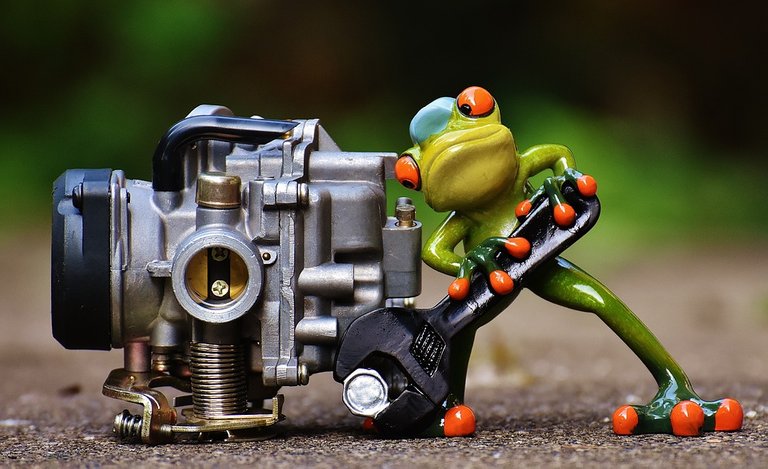
That's not me, its a frog! source
Let’s do some chemistry (I must confess, I am not a fan of chemistry but when talking about the combustion of fuels, it is quite impossible to eliminate the chemistry behind it.)
COMBUSTION
Combustion is defined by Oxford Dictionary as the rapid chemical combination of a substance with Oxygen, involving the production of heat and light. Basically, to burn (or combust) the fuel, it needs to be mixed with oxygen and luckily (or not) air is about 21% oxygen. So basically, the fuel needs to be mixed with air to ensure its combustion.
Here is a simple combustion equation of methane;
CH4(g) + 2 O2(g) → CO2(g) + 2 H2O(g)
THE CANDLE EXPERIMENT
How about a little exercise?
Take a candle and light it indoors. Place the candle on a table and watch it. As expected, the candle flame will glow graciously as far as it is getting the fuel (candle wax) and Oxygen (from the air in the room).
Now let’s add a twist to it;
Place a glass cup over the candle on the table and ensure the candle is totally enclosed in the cup such that there is no possibility of air entering the enclosed space.
Here is what is expected;
After a while the flame will diminish and sooner, it would die.
Okay, how about an indoor fire place?
If you light a fire indoor and you close all the windows and all possible means of ventilation (please don’t try this), the fire would burn (because the room is not a complete vacuum) but will be accompanied by a lot of smoke. In this case, there is supply of air but it is not enough.
Finally, introducing too much air would only make the fire burn wild and might eventually kill the fire.
These simple experiments prove the importance of air (Oxygen to be precise) in the combustion of fuels.
And with that, class is dismissed.
Recall that the combustion chamber of an internal combustion engine is an enclosed space (ideally a vacuum) and thus
there would be little or no air in the space naturally. Therefore in order to avoid the candle-in-a-jar scenario, there is the need to introduce the Oxygen (or air) along with the fuel.
Because the internal combustion engine is a sophisticated device, there is the need to ensure that the air and fuel delivered is in the right proportion to ensure complete combustion of the fuel and also to reduce pollution (fireplace scenario).
Here is something you can relate to
if something is being burnt with very little air supplied, it would burn with a lot of smoke and if more than enough air is supplied, the fire will burn low and wouldn’t be efficient. This also applies to the burning of fuel in the internal combustion engine.
Today I would not be talking about the chemistry of combustion (I still don’t like chemistry) but I would be talking about the devices used in the internal combustion engine (special reference to the automobile engine) to mix the fuel with the air before it enters the combustion chamber (the space where it is being burnt). The devices responsible for this are the CARBURETOR (small engines and older automobiles) and the INJECTOR (modern vehicles).
These two devices do the same job - they deliver fuel mixed with air into the engine but they do it in different ways.
Now let’s examine them one after the other
THE CABURETOR
As stated earlier, the carburetor is a device whose job is to mix the air and fuel in the proper ratio for combustion. Sometimes, the carburetor is referred to as the heart of the automobile because it does almost the same job; “it supplies the fuel and air needed to the engine in the right proportion” (maybe not the same job but very similar).
The word “carburetor” was gotten from the French word “carbure” which simply means to combine with carbon (maybe French is not as hard after all). However, putting a little chemistry into the word, it would mean putting more carbon into a fluid by mixing it with a volatile hydrocarbon.
The carburetor was invented in the 19th century alongside the production of the automobile (the automobiles needed the fuel to be mixed with adequate amount of air). Karl Benz however patented the carburetor as he was developing internal combustion engines and components. Ever since then, a lot of designs and modifications were done by inventors to suit the type of application the carburetor would be needed for.
HOW THE CARBURETOR WORKS
The carburetor operates on the Bernoulli’s principle. Simply put, “the pressure of a fluid decreases as the speed increases”. This is accomplished with the aid of a venturi. A venturi is simply a tube that is narrowed at the middle i.e. the radius of the middle is smaller than the other ends (more of like joining two funnels together at the smaller ends).
As the fluid (air) flows through the venturi and it passes through the narrow part, its speed increases and the pressure drops (according to Bernoulli’s principle) creating a vacuum or “sucking effect”.
That being said, the venturi of the carburetor is equipped with an inlet right in the middle which fuel flows through. The sucking effect produced by the drop in pressure is what pulls the fuel into the venturi and mixes the air and fuel. In order to adjust the air-fuel mixture, the carburetor is equipped with two valves that are in form of swivel. These valves are located at the top and bottom of the carburetor.
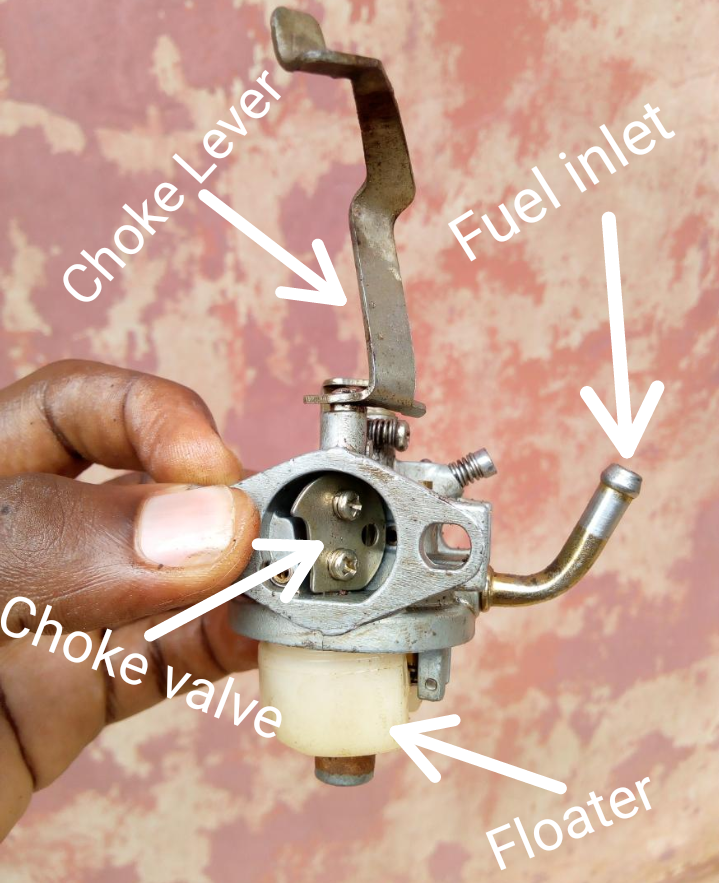
THE CARBURETOR SHOWING THE CHOKE AND THE FLOATER
The valve at the top is known as the CHOKE. It regulates the amount of air that comes in. when closed, there would be less air flowing through the pipe and thus, more fuel is sucked in and the engine gets what is known as a RICH mixture. This is usually suitable for conditions such as when the engine is just about to start.
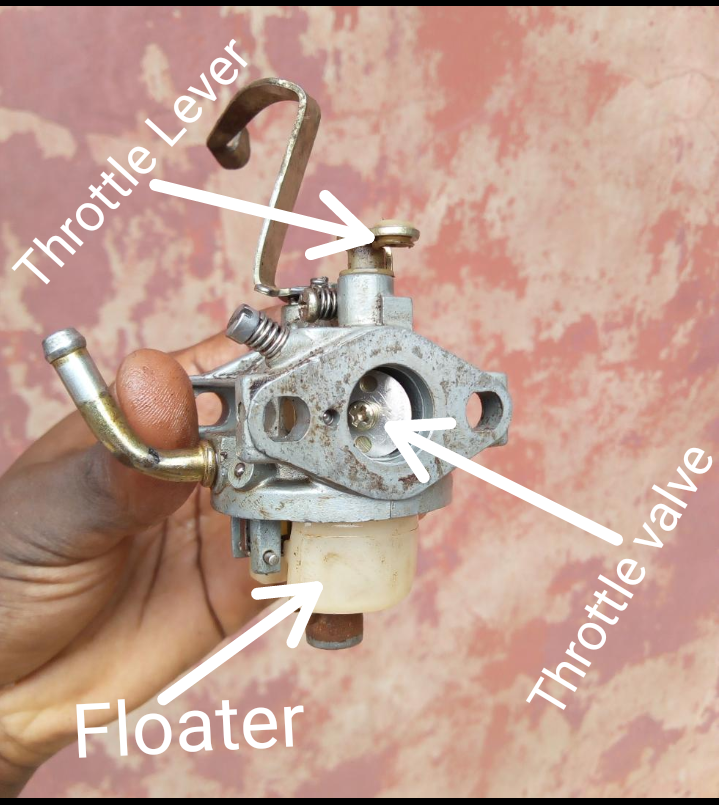
THE CARBURETOR SHOWING THE THROTTLE AND THE FLOATER
The second valve is known as the THROTTLE. I know this word is not new to us but it might have another meaning in this case (the one we know is the throttle pedal and yes, it is connected to this part of the carburetor). This valve controls the amount of air (mixed with fuel) that flows through the carburetor into the engine. The wider the throttle opens, the more power is delivered by the engine as a result of more air-fuel mixture coming into it. That is why in order to accelerate a vehicle, you press the throttle pedal (which opens up the valve as you compress. Cool right?).
Think about it as blowing a fire to make it burn more.
The last but not the least important part of the carburetor is the float-feed chamber. It is a kind of mini fuel tank which contains a float and a valve. The chamber feeds fuel to the carburetor and this feeding is controlled by the float falling and rising with the level of fuel in the chamber which opens and closes the refill valve respectively. Think of it like the ballcock in your toilet, yeah they do the same job. The job of this chamber is to control the amount of fuel that eventually flows into the carburetor.
How about a flow chart of the carburetor operation
|
When starting, the choke is closed to allow for less air entering and thus, a rich mixture is to be delivered to the engine
|
Movement of the air in the narrow part causes fuel to be sucked in as a result of increase in speed and decrease in pressure (thank you bernoulli)
|
When the throttle pedal is pressed, the throttle valve opens to deliver the air-fuel mixture into the engine
|
And the engine runs based on the amount of mixture you allow into it as a result of pressing the pedal
I think we have dwelled in the past for too long, why not come over to the present?
The carburetor reigned in the automobile engines for a while (and are still reigning in smaller engines) but as time went by, the requirements to control emissions birthed the introduction of catalytic converters which require the real-time control of the air-fuel ratio in accordance to the engine conditions. Unfortunately, the control was not feasible with carburetors (because of its mode of operation) and that brought about the invention of the fuel injectors.
THE FUEL INJECTOR
With the fall of the carburetor came the reign of the injectors in the automobile engine. Although the injectors and the carburetors do the same job, their mode of operation differs.
the carburetor draws fuel into a stream of air with the aid of suction by pressure difference but the injector atomizes fuel under high pressure through a small nozzle.
Have you ever used an aerosol spray before? (I expect yes as an answer), well, the injector delivers fuel to the engine inlet manifold in that manner. By spraying the fuel in this manner, the injector atomizes the fuel i.e. breaks into smaller particles so that it can mix easily with the air. From there the air-fuel mixture goes into the engine normally.
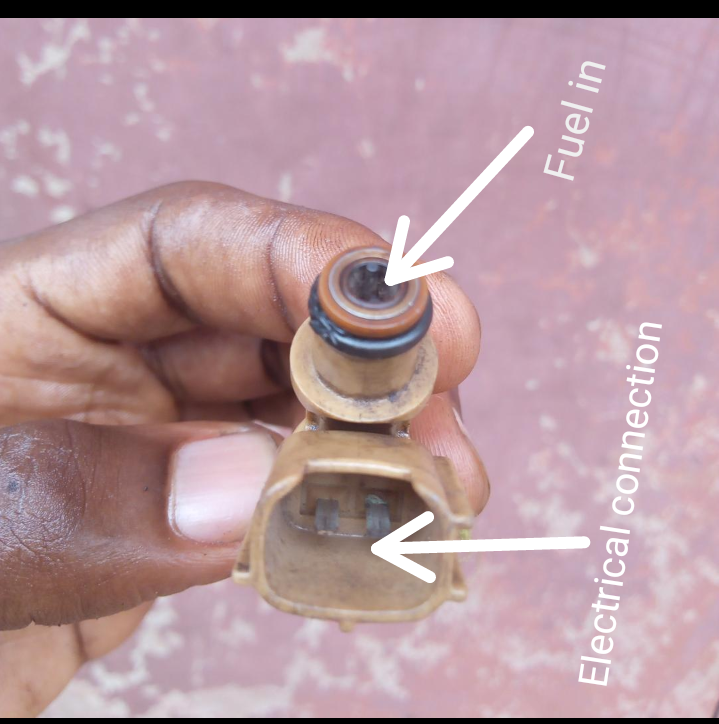
THE CARBURETOR SHOWING THE CHOKE AND THE FLOATER
The injector is mainly of two types based on how they are controlled; mechanically and electrically controlled.
The injector consists of a spring that is loaded in the closed position. For the mechanical type, the injector is opened by fuel pressure. However, in the electrically controlled injector, the system is opened by an electromagnet (or solenoid) which is controlled by the E.C.U. The electrical controlled injectors are widely used in recent years since almost all vehicles are electrically controlled with the E.C.U at the center of operations.
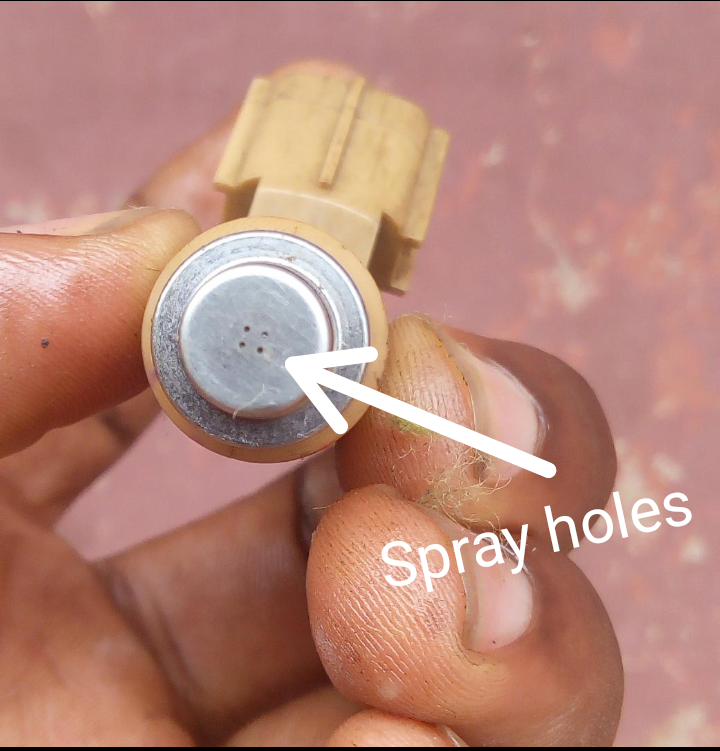
THE INJECTOR SHOWING THE SPRAY HOLES
The injector has its ends equipped with tiny holes where the fuel passes through. the position of these holes depends on the type and orientation of the injector and engine it is used for. The injector in the picture beside has four holes from which the fuel is sprayed. You can imagine how easily the fuel would mix with the air.
Each engine cylinder has its own injector which delivers the atomized fuel + air at the accurate time it is required (the power stroke) unlike the carburetor engines which have only one carburetor serving multiple cylinders thus, the cylinders might not get equal amount of the air-fuel mixture
The E.C.U uses information gotten from various sensors including the throttle position sensor, the mass air flow sensor, the oxygen sensors and others.
the injector is simply an electronically controlled valve capable of opening and closing multiple times per second
How about another flow chart?
You start the engine
|
The fuel pump supplies fuel under pressure to the fuel lines connected to the injectors
|
Immediately before the power stroke, the e.c.u send signal to open up the valve depending on the operating conditions
|
Your leg on the throttle controls how much air is allowed into the intake,and the e.c.u cordinates the corresponding amount of fuel to be added
The animation below also explains the working of an injector.
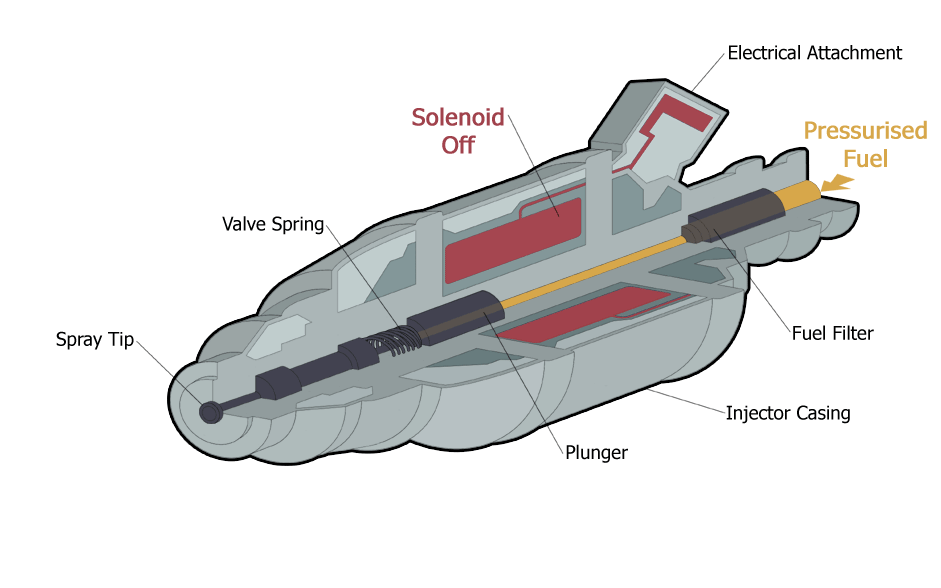
source: WIKIMEDIA COMMONS licensed under the Creative Commons Attribution-Share Alike 3.0 Unported
The injector however has a lot of advantages over the carburetor. Listed below;
- Throttle response is smoother and more consistent during conditions such as quick throttle transitions.
- Injectors have the ability to operate no matter the orientation i.e. they can be mounted upside down and still perform whereas the carburetor with floats cannot do same.
- Engines with injectors have a higher fuel efficiency
- Emissions from injector equipped engines are cleaner as a result of the precision that comes with the delivery of the air-fuel mixture.
Modern vehicles have dumped the use of carburetors and embraced the injectors for the reason of their efficiency and smooth operations. An injector engine is also quite easier to troubleshoot as the E.C.U records the signals it gets from the various sensors in times of a fault. However, the carburetors still find application in smaller engines such as the small generators like the one I dismantled here, the lawn mower engines and so on.
CONCLUSION
As the years go by and technology advances, inventors always find a way to solve the problems a previous invention presents. As at now, electric cars are already available and this totally eliminates the dependence on fossil fuels to power the automobile. Although as long as the internal combustion engine is still around, the carburetors and injectors would still find relevance.
Thank you for reading my blog, I hope you have learnt something. Feel free to drop a comment as I am waiting for that. I am a proud member of the #steemstem community!
REFERENCES
1. fuel injection All images not referenced were taken and edited by me. hereblog@steemstem here and this guidelinesproper use of images devoid of copyright issues hereIf you write STEM (Science, Technology, Engineering, and Mathematics) related posts, consider joining #steemSTEM on discord . If you are from Nigeria, you may want to include the #stemng tag in your post. You can visit this by @stemng for more details. You can also check this blog post by here for help on how to be a member of @steemstem. Please also check this blog post from @steemstem on
2. injector
3. how a fuel injection system works
4. how fuel injection systems work
5. carburetors
6. how does a carburetor work
7. carburetor
8. Bernoulli’s principle
9. venturi effect

Excellent post, with some great photo editing skills to inform the reader to a great degree. It is important for all readers to understand the importance of the Bernoulli Effect as this is applied to all aspects of fluid mechanics, which greatly influence our lives daily. Keep up the good work !! :)
Yeah, the Bernoulli effect is of great importance when dealing with fluids.
Thanks for reading
Definitely worth the read !!
Nicely done! With engine control unit being employed in most engines, carburetors may get completely obsolete in next few years.
You are absolutely right. The carburetor gradually getting "extinct"
Keep on force feeding us all these automobile post. It's delicious tho 😋. Do you know anyone who posts chemistry stuffs?
Lol. I love sharing my knowlege of the automobile. I am sure you love it too.
I don't know any chemistry authors. Do you?
This is a detailed and explanatory post, with no prior knowledge of engineering. Well done @rharphelle.
Thank you. I'm glad you enjoyed it.
I would say you did a good job except for the chemistry aspect where you failed to respect chemistry.. You should find a way to present superscript and subscripts to us.. Other than that you did a wonderful job. Well done @rharphelle
Lol, i am not a lover of chemistry though. It gives me the "reaction"
@rharphelle is here again... Thanks for labelling out the carburetor and how it works. Great post as always.
Thanks for stopping by Sir.
If a rich mixture is present, possibly due to carburetor float problems or a sticking choke, you'll get poor fuel mileage.
Nice piece.
Correct, that's more reason the injector came in. There are no overfloat issues in injector systems
This is beautiful...I'm glad to have known the advantages of injectors over carburator!
Those principles were well explained..Kudos
However, i'm still waiting for the Teslas of this world for much availability of the awesome invention of the electric vehicles....I wanna drive one soon.
Yes, the electric vehicles have come to stay!
Thank you for visiting my blog
The past was the carburetor, the present is the injector. What will be the future? :)
Nice piece bro
Maybe the ejector lol
Lol maybe the ejector 😛
Lol. Your sense is there bro
The future is here already nah! We have the electric cars.
Replacing the internal combustion engine outrightly.
Thanks for visiting
@kingabesh i see you!
What of hybrid cars, do they have internal combustion engine?
They have both internal combustion engine and an electric motor 😁.
I guess I love that one :)
Who no like better tin?
smh..u and @kingabesh, wehdone o
I see you @mrbreeziewrites
Mr Breeze, I sight you
Its hard for me to comment on post related to Engineering cos its not just my thing.
However i appreciate the effort put into this.
Is there any particular reason why the carburetor is being replaced by the fuel injector...., they do the same thing i think.
The major reason the injector replaced the carburetor is because the injector can be controlled by the vehicle's computer - the E.C.U. So, its more like saying the carburetor is analog while the injector is digital 😁.
The ability to control the injection of fuel into the engine helps to control emissions and also improves fuel economy.
Hope i made sense.
Another great work from the "Mechanic". This is refreshing. One day, u'll force me to be in love with automobile.
Chemistry really sickens me too.
Thanks for sharing this..At least I now know why injectors gradually replaced Carburettors. Only for it to be seeing its own successor already too...
Yeah, thats a sign that technology is always on the move and we should also try our best to move with it.
Thanks for dropping by!
Yeah sure, don't ever get stucked. Ji! Ma sun!